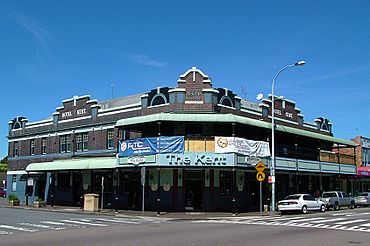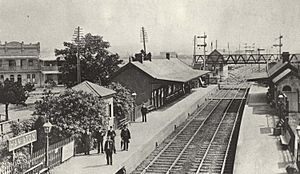Hamilton, New South Wales facts for kids
Quick facts for kids HamiltonNewcastle, New South Wales |
|||||||||||||||
|---|---|---|---|---|---|---|---|---|---|---|---|---|---|---|---|

The Kent Hotel, est. 1924, is a landmark on Beaumont Street
|
|||||||||||||||
| Population | 4,229 (2016 census) | ||||||||||||||
| • Density | 3,020/km2 (7,800/sq mi) | ||||||||||||||
| Established | 11 December 1871 | ||||||||||||||
| Postcode(s) | 2303 | ||||||||||||||
| Area | 1.4 km2 (0.5 sq mi) | ||||||||||||||
| Location | 4 km (2 mi) W of Newcastle | ||||||||||||||
| LGA(s) | City of Newcastle | ||||||||||||||
| Parish | Newcastle | ||||||||||||||
| State electorate(s) | Newcastle | ||||||||||||||
| Federal Division(s) | Newcastle | ||||||||||||||
|
|||||||||||||||
Hamilton is a suburb in Newcastle, New South Wales, Australia. It is located about 4 kilometres (2.5 miles) west of Newcastle's city centre. Hamilton has a busy main street called Beaumont Street. This street is known for its many restaurants, shops, and services. It has a lively feel with people from many different cultures.
Contents
Discovering Hamilton's Past
The City of Newcastle respects the Awabakal and Worimi peoples. They are the original custodians of the land where Newcastle is today. This includes its rivers, wetlands, and coastlines. Their connection to this land goes back thousands of years.
How Hamilton Got Its Name
Hamilton became its own town, called a Municipality, on December 11, 1871. It was named after Edward Terrick Hamilton. He was an important leader of the Australian Agricultural Company (AA Co). This company played a big part in Hamilton's early growth. They owned most of the land and ran the coal mines.
The Start of a Mining Town
The town of Hamilton began when coal was found near St Peter's Church. This area was first known as Pittown, Borehole, or Happy Flat. A deep hole was dug for coal in 1849. This mine was called the D Pit or borehole. Pittown was built near today's Beaumont Street. It provided homes and services for the miners and their families.
By 1928, Hamilton had more than 400 shops. This was a big jump from only 80 shops in 1909.
A New Community: Italian Settlers
In 1947, a group of nearly 150 Italian families arrived. They were from a village called Lettopalena in Italy. They first settled in Islington. Soon, they moved to nearby Hamilton and Mayfield. This was because Islington was close to the BHP steel works.
Hamilton, especially Beaumont Street, became a strong centre for Newcastle's Italian community. By the late 1950s, the local Italian community often visited the Exchange Hotel. This hotel is still a popular meeting spot for Italian men in Hamilton.
The Mechanics Institute: A Place for Learning
In the early 1800s, education was mostly for the rich. To help working people, Mechanics' Institutes were created. They started in Britain and then came to Australia. Their goal was to offer technical education. They had talks, classes, and books in a reading room. This gave many workers a chance to learn and read.
Over time, new places like TAFE colleges and public libraries offered similar services. This made Mechanics Institutes less important. To earn money, the institute would host dances, plays, and movies. They also rented out billiard tables.
Building the Institute
The Hamilton Mechanics Institute was founded in 1859. Its building was constructed in different stages between 1869 and 1903. The institute got land on Gray Street in 1859. But meetings were first held in private homes or rented rooms.
The first building was made of wood in 1862. A lecture hall was built in 1869. In 1872, a Free Library was added. The original building was later replaced. In 1879, a large room called the Learmonth Memorial Hall was added. This room was named after Alexander Learmonth, an early supporter. In 1888, a new Victorian building was designed by architect Frederick Menkens. The premier of NSW, Sir Henry Parkes, opened this building in August 1888. An extension was finished in 1891.
In 1903, two more large rooms were added to the back. By the early 1920s, the institute had about 800 members. The downstairs hall could hold 400 people. In the 1940s, the Hamilton RSL bought the building. They renamed it Anzac House.
The building used to have decorative cast iron verandahs. These are common in 19th-century buildings but often do not survive. The building has since been renovated into apartments. This work was completed in January 2018.
Important Historic Places
Hamilton has several places listed for their historical importance:
- 195 Denison Street: Australian Agricultural Company Mine Manager's House
- Great Northern railway: Hamilton railway station
People Living in Hamilton
| Historical population | ||
|---|---|---|
| Year | Pop. | ±% |
| 2001 | 3,959 | — |
| 2006 | 3,711 | −6.3% |
| 2011 | 4,071 | +9.7% |
| 2016 | 4,229 | +3.9% |
The 2016 census counted 4,229 people living in Hamilton.
- About 2.8% of the people were Aboriginal and Torres Strait Islander people.
- Most people (80.3%) were born in Australia. The next largest group came from England (2.4%).
- Most people (82.6%) spoke only English at home.
- The most common beliefs were no religion (38.5%), Catholicism (21.7%), and Anglican (13.6%).
Getting Around: Transport in Hamilton
Train Travel
Hamilton's train station was built on the line to Newcastle. The station is 164 kilometres (102 miles) from the main railway office. It is also 5.8 metres (19 feet) above sea level. When the station opened in 1872, Hamilton became a more important suburb.
The station serves trains on the Hunter railway line, which goes to Maitland and beyond. It also serves the Central Coast & Newcastle Line, which travels to Sydney.
Bus Services
Hamilton is home to Newcastle Transport's main bus depot. This is where many of the city's buses are kept and maintained.
Local Sports Teams
Hamilton has several local sports teams:
- Association football (soccer) – Hamilton is represented by Hamilton Azzurri FC.
- Rugby union – The local team is the Hamilton Hawks.
- Rugby league – The Hamilton Ducks Rugby League Football Club plays in the Newcastle & Hunter Rugby League.
Gallery








